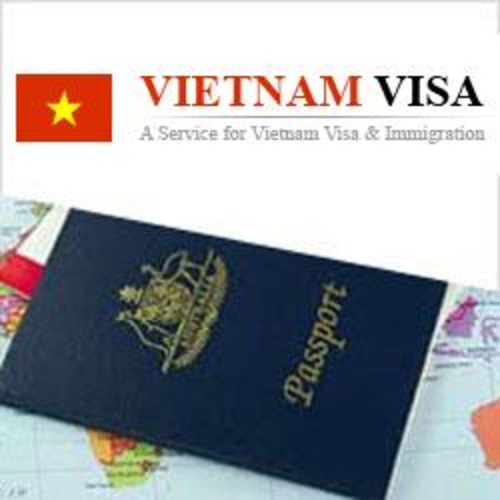Hanoi
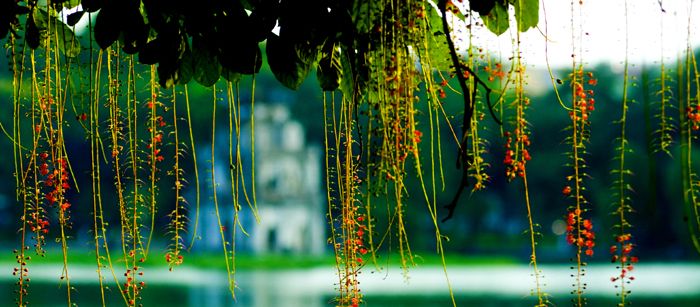
Overview
Hanoi is the capital of the Socialist Republic of Vietnam. It owes its name to the surrounding Red River (Ha: river, Noi: interior; Hanoi: city within the river). Spreading over an area of 921 km2, in 2009 the population of Hanoi and its surroundings is estimated to be more than 4 million inhabitants.
Formerly known as the city of the Dragon rises (Thang Long), Hanoi, which name was given by the Emperor Ming Mang, 1831, has undergone profound changes since the country opened at the beginning of the the 90s of last century. Speedy and sometimes mismanaged urbanization somewhat transformed the poetic face of this charming town, despite the Government’s efforts in the conservation of old neighborhoods. From this marriage between past and present, between antiquity and modernity, born a new city of extreme diversity. Hanoi is a city full of temples and pagodas, a brilliant colonial city surrounded with greenery, city notables, a market town in its narrow streets, a dream city reflects itself on its mirror lakes.
"Palaces, pagodas, colonial houses, buildings of Soviet inspiration: the story of Hanoitakes place between Asia and the West. Long under the tutelage of China, the "City of the Dragon Rises" took off from 1010. Over centuries and dynasties, it has become a true imperial city.Its golden age in the 15th century under the Le Dynasty, marked the culmination of Confucianism. Scholars and mandarins then animated a sumptuous court whose expenses enriched civil city. The metropolis of Tonkin first impresses Western travelers who land on the banks of the Red River in the 17th century. Hanoi was the "city of thirty-six streets," the city of merchants and artisans, the jewelers, silk weavers, manufacturers of paint, paper and drums. Later after the French colonial time, grandiose public buildings was built in Hanoi in the Soviet style at the time of the Social Republic of Vietnam If youhave enough time, this great northern city deserves spending several days as the its rich culture and history are present in every corner.
Must Hanoi sites and surrounding area.
One Pillar Pagoda
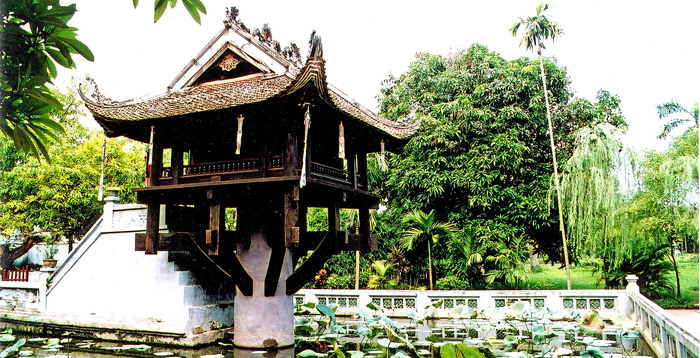
One Pillar Pagoda was built in 1049 under the reign of Ly Thai Tong.
A legend relates that the Kinghad no son and often came to pray in pagodas. One night he saw in a dream the Goddess Quan Am sitting on a lotus in a square lake located in the West of Thang Long (in popular imagination, the spirits live in the West) tending a little boy. Sometime later, theQueen gave birth to a crowned prince. The king was therefore built the pagoda in the shape of the lotus flower he had seen in the dream to thank the Goddess.
Because of its original architecture and historical value, the One Pillar Pagoda was chosen as the emblem of the city of Hanoi.
Quan Thanh Pagoda
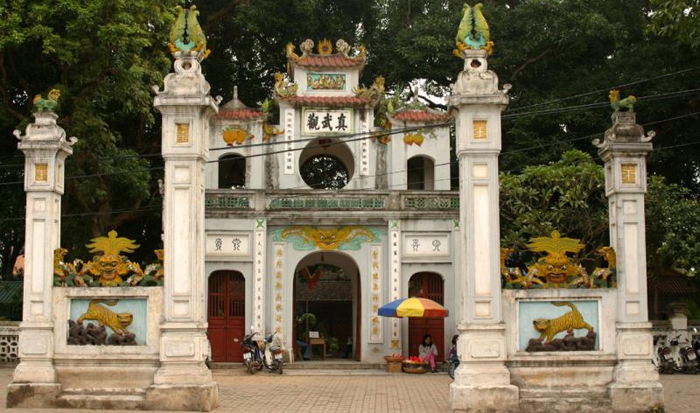
Located in the North of the old tow,n on the bank of Truc Bach Lake, Quan Thanh pagoda was built in the eleventh century in honor of Huyen Thien Tran Vu, the protector of the country. It is characterized by a large bronze bell, added to the building in 1677.
Tran Quoc Pagoda( or national defense Pagoda)
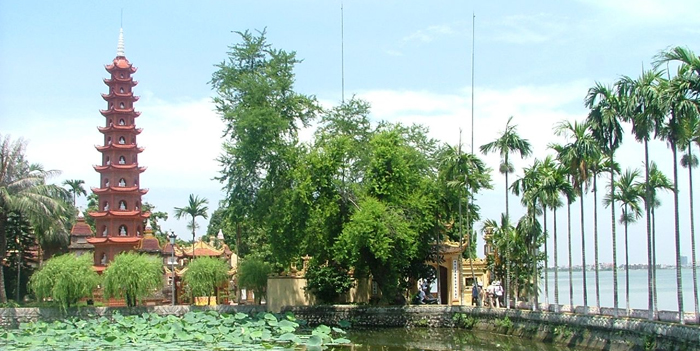
Located in an island connected to the eastern shore of West Lake (Ho Tay), Tran Quoc Pagoda is the oldest pagoda in Vietnam. Its construction dated back to 514 and one of its restorations dated in the fifteenth century (according to a stele placed on the pagoda in 1639).
Originally located on the bank of the Red River, it was damaged by a landslide then transferred to the West Lake.
Please note that the pagoda is also known as the Pagoda ofNational Defence..
The flag tower
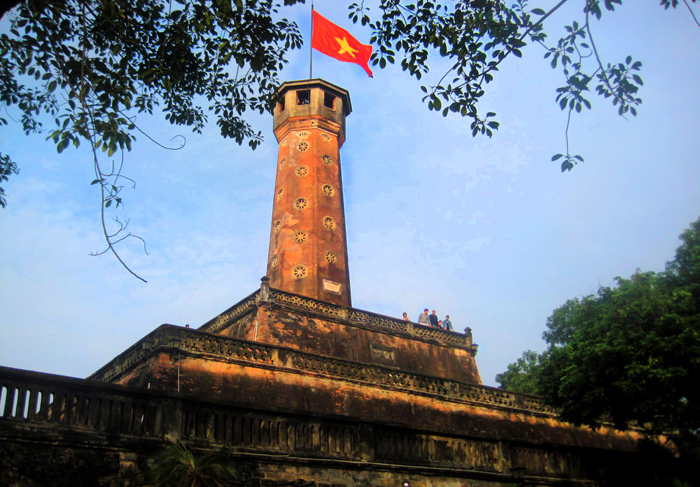
The flag tower of Hanoi is a beautiful octagonal tower, built of red brick with multiple openings (39 rosettes and 6 fans). It was built on a pyramidal base with a square base to 3 levels ofdifferent heights connected by exterior or interior stairs and doors. On the small esplanade of the summit, stands a fine round tower with flag. The height of the tower is about 60 m.
It was built in 1812 in the citadel in 1805 (destroyed by the French colonialists in 1895 but the tower was used for observation and communications). The citadel itself was based on the ancient imperial city.
On the other side of the avenue from the tower is green wooded park where there is a statue of Lenin. It is also nearby the Army Museum whichworths a visit for historical information (weapons, documents, photos, models, films).
Lake of the Restored Sword( or Hoan Kiem Lake)
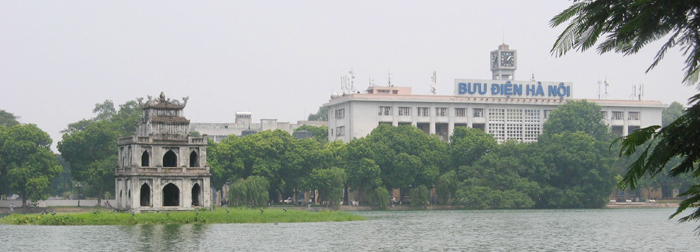
Lake of Restored Sword is probably the first image that the word Ha Noi evokes in Hanoians living far from home and the first inspiration for romantic compositions. This "bouquet of flowers” in the heart of Hanoi takes its name from a legend in which King Le Loi was entrusted with the sacred lake turtle, when he wasfishing one day, a sword which he is utilized during the resistance against Ming invaders in the 15th century. After independence regained, the king was taking a leisure ride one day on a boat in the lake when the turtle returned to the water surface to claim the sword, the king restored him without hesitation. He immediately changed the name of the lake, previously called "Emerald Lake" due to the green color of the water to the Lake of Restored Sword
This story raises a variety of interpretations. Some see the entire Buddhist philosophy according to which everything has an end and we should learn to make things to whom they belong. For others, the story reflects the peaceful character of the Vietnamese people, who takes up arms only when it is forced.
Whatever the truth is in this story, it is undeniable that the lake, with its extremely poetic landscape, is a real spot of charm that makes the Hanoi an attractivedestination for all..
The Ngoc Son Temple

Ngoc Son temple, which name means Jade Mountain, occupies the largest island of the Restored Sword Lake, in the center of the city.
Located in a former palace of the Lords TRINH from the 14th to the 18th century, the temple became a pagoda dedicated to Buddha and a shrine dedicated to the worship of the Gods of War (including General Tran Hung Dao, winner against Mongols in the 13th century), the spirit of soil, traditional medicine and literature in the 19th century.
The architectural complex exudes an atmosphere of literature and humanist culture. It includes a portico behind an old tree whose flowers glow in the beginning of the summer, an obelisk topped with a brush, door arches surmounted by a stone inkstand, a graceful red wooden bridge called "Bridge of the Rising Sun" that leads to the island. Stretched abouttens meters length, the bridge connects the modern world (as one end of the bridge is the busiest street of Hanoi) and the world of myths. Therefore it is very interesting to go on deck at night to feel and experience this inevitable separation.
Inside the temple, there is a statue of the Master of literature scholars with two mandarins. In short, it is a place of worship of literature, which for centuries was the first acceding to the aristocracy.
The temple is also place for workship Nguyen Sieu (1799-1872), known in poetry circles "Sieu the Divine", author of numerous books of prose,poetry and excellent scholarly works on literature, philosophy, geography etc. .
It is also here that we find the corpse of a 2.1-metre-long giant tortoise, caught dead in the lake in the 80s and whose age is estimated at a few hundred years. This animal living in the holylake, which still shows its gigantic head a couple of times a year, kept alive the legend of the Restored Sword.
Long Bien Bridge in Hanoi

Long Bien Bridge, located near the old town, was designed by Eiffel and built by the French company Daydé - PILLIE for four years from 1898 to 1902. It was the beginning of the century the name of the Governor General of Indochina Paul Doumer.
With a length of 1682 meters, it was the only way to cross the Red River until the 1980s and, consequently, the target of U.S. bombing in 1967. Hundreds of attacks have transformed the initial configuration of the bridge and seriously affected its strength.
Renovated several times, the bridge is currently undergoing a major restoration project for which funding would be supported by the French Government. This project promises to modernize the bridge, while preserving its shape.
Reserved for pedestrians, two wheels and rail traffic, the Long Bien Bridge is a privileged walk to watch the Red River in peace and feel the call of the past.
"Whenever I stroll on the bridge (...), I am assailed by conflicting feelings at the sight of the water responsible for the river alluvium over 1000 Km carries along its course.
On the one hand, to the melancholy of the Chinese poet Li Po remind me of the passage of time and the vanity of this world:
"Do not you see that the waters of the Yellow River coming down from heaven, Hasten to the sea and never come back ? "
On the one hand, when I look upstream break the waves, my heart overflows with gratitude and affection for my distant ancestors who had the first millennium BCE, forged our national identity by creating civilization red River..."
The mausoleum of Ho Chi Minh
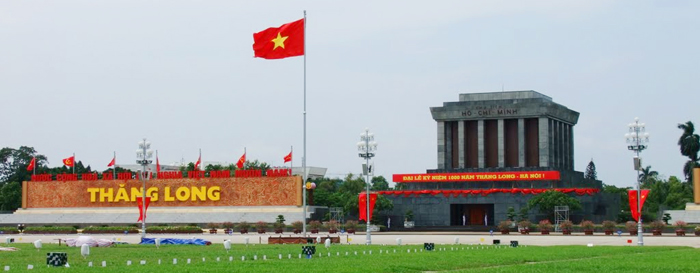
The mausoleum of Ho Chi Minh overlooks Ba Dinh Square, historic place was proclaimed by the late President, September 2, 1945, the country's independence and the creation of the Democratic Republic of Vietnam. 21.6 m high, this stylized form of a monument lotus flower was built for 2 years, with Soviet aid, to be opened August 29, 1975, four months after the country's reunification. It is in this impressive and massive construction in granite and marble transported from the center of the country that the founding father of independent Vietnam, whose popularity owes much to the simplicity of his lifestyle and that independence and freedom based are more important than comfort, "nothing is more precious than independence and freedom."
The construction of the mausoleum in fact did not meet the wishes of Uncle Ho, who rather wanted to be cremated ( so that it is clean, he said) and that the ashes be scattered in the three regions ( North, Central and South), a sign of unity. The decision to build the monument at the time officially explained by the desire of the leaders of the Communist Party of Vietnam to enable the Vietnamese , especially the southerners previously occupied by the Americans , to see the President in flesh and bone and honor him.
But if we see every day thousands of people queuing, sometimes in bright sunlight to enter see their idol, we can appreciate the significance of this decision, it is contrary to the will of the deceased, to the extent that the mausoleum has become a bridge between the people and a system, including Ho Chi Minh, the national hero, laid the first foundations.
Visit the mausoleum is followed by the house of Ho Chi Minh, which is located in the large garden behind. Visit not less impressive, as it allows to measure the contrast between the life of the President and the post mortem fortune that he reserve. Refusing to live in the old palace of the Governor of Indochina, the strong man of the time built, probably under the influence of Confucian education he enjoyed in his youth, at the edge of a pond where he raises fish, a small house made of teak wood which he imagined architecture and scheduling. Combining simplicity and modernity, this house which was at the same time the office of President from 1958 to his death (1969) is built on stilts and surrounded by beautiful trees. Style simple and very refined construction reflects the detachment of the great communist revolutionary for any glitz.
Museums in Hanoi
The History Museum
Set in the beautiful old colonial building of the French School of Far East, History Museum, founded in 1958, has an exhibition area of 2000 m2. It is divided into four main sections: prehistory, the country's founding dynasties Tran ( 1225-1400 ) dynasties Ho ( 1400-1407 ) dynasties of Nguyen ( 1792-1945 ) Culture and champagne .
With nearly 7000 objects ( drum, bronzes, pottery and weapons, tombstones, terracotta relics, household objects, carved stones, Cham sculptures, pagodas remains.... ) and extensive documentation, the History Museum traces the whole process of development, process marked by many wars of resistance through the centuries.
The Ethnographic Museum
Located on a large site of 3 hectares, the museum of ethnography - the result of a Franco- Vietnamese cooperation was launched at the 7th Francophonie Summit held in Hanoi in 1997.
Present life the ethnography museum aims , manners and customs of the 54 ethnic groups in Vietnam. It is divided into 9 sections corresponding to different ethnic groups. We can see then tens of thousands of objects and 15,000 images representing these peoples costumes, musical instruments, fishing instruments , rituals and ceremonies ...
On the grounds surrounding the museum reconstructions of typical villages and houses parts of the country allow visitors to better understand the rich cultural expressions of Vietnam.
Visit the Ethnographic Museum is an essential step in the transition to Hanoi.
The Museum of Fine Arts
Founded in 1966, the Museum of Fine Arts is housed in the old building of the boarding Joan of Arc High School girls in colonial times, just in front of the Temple of Literature. It is divided into 5 sections: prehistoric art, Vietnamese art from the 11th to the 19th century, Vietnamese art in the 20th century, collections of folk art , ceramic art of Vietnam.
Buddha statues and monks wood, paintings of Chinese influence, sculptures from the 12th and 13th centuries, paintings on silk and lacquer, charcoal and wood engravings, scenes of peasant life, pottery .... offer the visitor a view panoramic view of the characteristics and evolution of Vietnamese art .
The Museum of the Revolution
Established in 1959, the Museum of the Revolution is mainly devoted to the war of resistance against French colonialism and the Vietnam War. With 29 showrooms and thousands of objects and documents halls, the museum provides an understanding of how and why a small country was able to resist and overcome so heroically two world superpowers.
It finds: the history of French anti-colonial movement, the entry into politics of Ho Chi Minh, stories about the struggles, strikes, the creation of the Communist Party in 1930 and the creation of the Vietminh, photos homemade bomb factories in the jungle, the Tet Offensive in '68, the American bombing of North 's victory in 1975 and the reunification of the country.
For those who are particularly interested in the Battle of Dien Bien Phu and military tactics, the museum of the revolution must be complemented by that of the Musée de l'Armée.
Museum of Ho Chi Minh
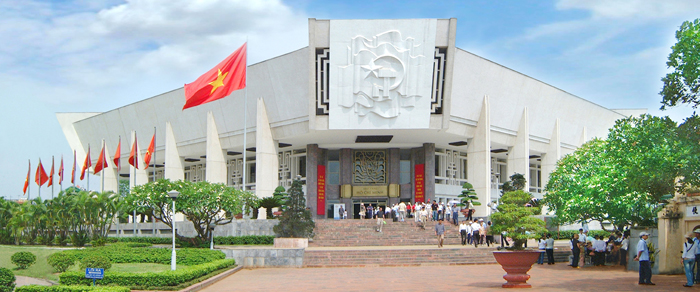
Located near the mausoleum of Ho Chi Minh, the museum of the same name was launched in 1990 to mark the 100th anniversary of the late President.
The museum is essential for those wishing to understand the life and revolutionary actions of the great leader, from his birth to his last hours, through his stays in France, the United States, the Soviet Union and the remote regions of the North- west. Presentations on the life of Uncle Ho, which are made in close liaison with political and social circumstances, allow us to understand how a great man is shaped by his time.
The Museum of Vietnamese Women
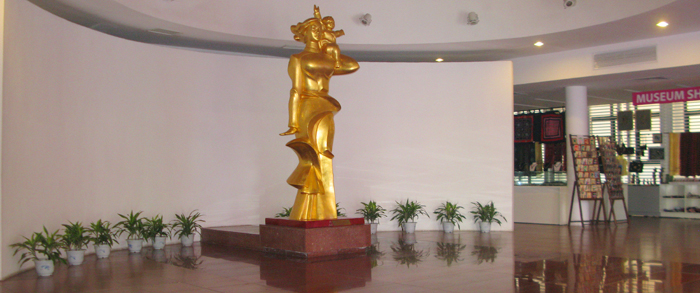
Surrounded by the greenery of the flamboyant, the Museum of Vietnamese women was inaugurated in 1995, on the occasion of the 65th anniversary of the National Women's Union.
Visiting this museum allows us to understand the particularly important role of women in both wars in the reconstruction of the country and the place of women in contemporary Vietnamese society
The Hanoi Opera House
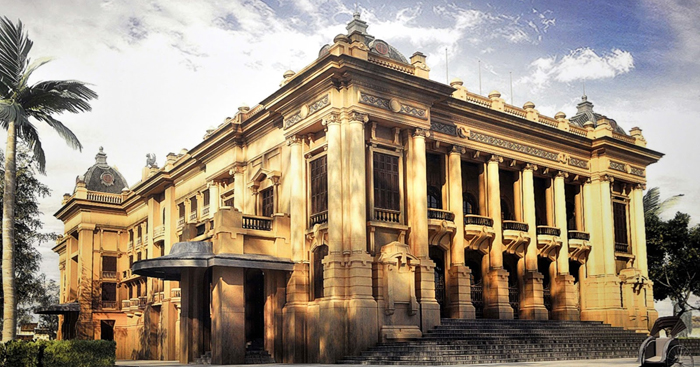
The opera is a colonial architectural monuments still well preserved until today. Built in 1911 by the inspiration of the architecture of the Opera Paris, today it is the largest theater in the capital, with around 900 seats. It was renovated in 1997 at the summit of the Francophonie. A wedding season (from September until the end of the year) , we regularly see the future married outside the building to take pictures , no doubt hoping that their marriage will last as long and will remain forever as beautiful as the building (who wants her wedding to be like a play ?).
Instead of opera , known as Revolution Square in August, is small but very beautiful, because surrounded by beautiful monuments including the luxurious Hilton hotel, the haute couture shops and cafes class . It is here that August 17, 1945, residents of Hanoi had the opportunity to see for the first time the red flag with the yellow star hovering on the balcony of the opera. It was also here in 1945, a public meeting was unleashed in a parade supporting the August Revolution.
The Temple of Literature
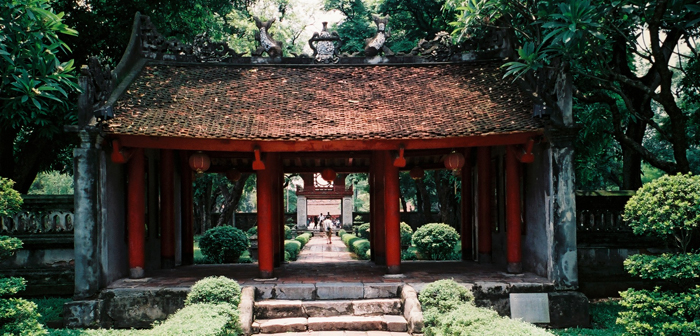
Built in 1070 during the reign of King Ly Thanh Tong, the Temple of Literature is the first university of Vietnam. Long known as the Imperial College, he was originally booked to princes and son very high dignitaries before democratize welcoming , from the 15th century, some deserving but impecunious provincial student whose studies are supported by the Court. It taught Confucian thought and morality from four classic books ( The Great Learning , the Mean, the Analects and Mencius works ) and five canonical books ( The Odes , Annals , The Book of Changes , the Book of rites and the Annals of the spring and fall ) . Under the reign of Le Thanh Tong (1460-1497), the College had its heyday and included schools, conference rooms and a library. It became a great school and a center of administration letters, bridge between the academic world and that of the administration.
Moreover, it is THE Thanh Tong who made the building project stelae in honor of all the scholars who passed the examinations and competitions, initiated the project in 1442. There are now 82 steles honoring the winners of competitions for recruitment to the public service, which took place in the capital between 1442 and 1779, 82 promotions. These steles rest on a stone pedestal in the form of turtle, symbol of longevity and the union between heaven and earth , the turtle shell with a round and curved ( Heaven) and a square and flat stomach ( Earth). Each stele recounts the circumstances of the competition, exalts the sovereign who organized and provides a list of winners.
The references to the oldest monument, the built in 1442, clearly state the political principle behind the rule: "The wise and learned are the roots of the state. When these roots are strong and numerous, the state is unwavering. The duty of the Prince is to ensure the smooth running of the competition and to entrust the public functions that people whose knowledge and wisdom have been proven ... ". The big lesson is regularly recited today, when recruitment to the public service, affected by corruption and favoritism, poses a lot of problems.
In the early 19th century, the Imperial College is transferred to Hue city center of the country where NGUYEN decided to establish the capital. The Temple of Literature is now for the commemoration of Confucius and his disciples. It also hosts the last few years, the National Poetry Day. Renovated in its original form in 2000 as part of the celebration of the 1000th anniversary of Thang Long - Hanoi, Temple is an almost obligatory stop for visitors to the capital.
Old Hanoi with 36 streets

In "Vietnam between two myths", published in Paris in 1982, Claude Palazzoli wrote this about the alleys of the old city: "No concrete. But pleasant houses all tight, clustered, stunted and none resembles another, narrow, pointed, potbellied, stumpy, chassieuses and overloaded with embellishments and balconies, terraces, vases, balustrades and columns, indescribable and tasty " Through the vicissitudes of history, the soul of the city Thang Long remained in this district with its new shops of artisans and merchants. The old quarter is as a mulberry leaf midrib which is the artery of the Silk Road - Grand Dong Xuan Market, north of Green Lake task of the Restored Sword. This axis, radiates a multitude of streets and alleys that go right to the dike of Red River and left to the ancient citadel.
In the 15th century was already visible in its main lines the face of the city 's thirty- six blocks and corporations, with evocative names: Silk Street Street vermicelli Street hemp , cotton street , street sails Street coffins Street mats, bowls streets , street drugs , street paper votive objects , street grilled fish ... life there bubbles on the sidewalks. The configuration of the old quarter was due to the accumulation of small villages and hamlets bringing together people of the same corporation or even a traditional business. These supporters, although conscripts by the king, began to settle near the royal city in the 13th century, where they made and sold their traditional products.
With the transition to a market economy, the old neighborhood change. New businesses grow there and the whole area becomes, following the explosion of all kinds of small shops, a huge shopping center. One sees hotels, cafes, restaurants, grocery stores, fabric shops ... But behind this modernist aspect, the old quarter remains the place where strongly felt the most characteristic features of Hanoi. The narrow streets and the incredible human density give this area a particularly lively atmosphere in which human relationships are formed easily.
Nearby Hanoi
The village of Bat Trang
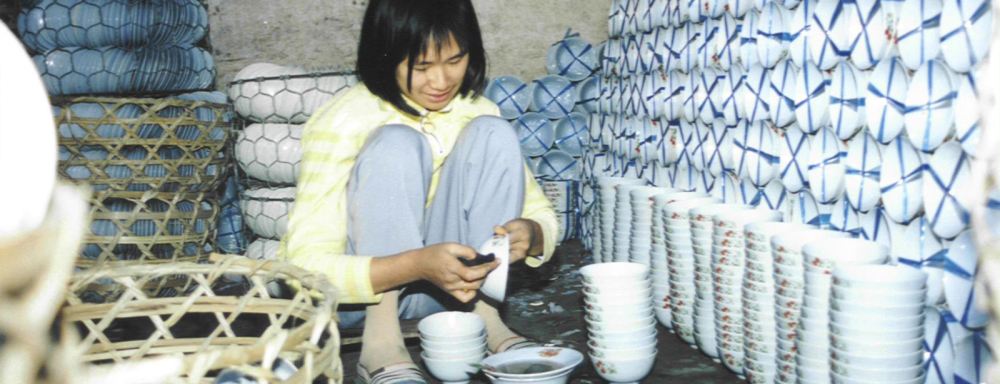
Pottery village of Bat Trang is located twenty kilometers east of Hanoi. This is done by a small road along the Red River and through a beautiful agricultural region.
The face of the village of Bat Trang (meaning "oven bowls ") has changed so much over the last ten years that the very term "village" would suit him more. It became a town of rich families, crossed by a society dominated by multi-storey houses that are most often stores where to buy street no one knows how many kinds of pottery and earthenware whose beauty is no longer to discuss. Several techniques, perpetuated for over 700 years, remain artisanal (molding, mold release, correcting imperfections, applying decals, paint for decoration) even if Bat Trang has been developed to become a shopping center on the edge of the Red River. Wood stoves and coal once gave way to electric ovens, considered less polluting and more profitable. The development of Bat Trang has served as a model for a broad recovery policy craft villages being implemented in Vietnam, in order to campaign hard life out of rice.
Product reputation of Bat Trang, which have long been exported throughout Asia, is due not only to know - how and especially the quality of the land, this land was once called "village of White Earth ".
Visit Bat Trang has any interest to the extent that the visitor can attend all manufacturing steps which enable him to understand the production process of the objects he uses every day. One can, of course, make purchases: even if the price is not lower than elsewhere for tourists, it is at least assured quality and has a greater range of choices.
The Perfume Pagoda
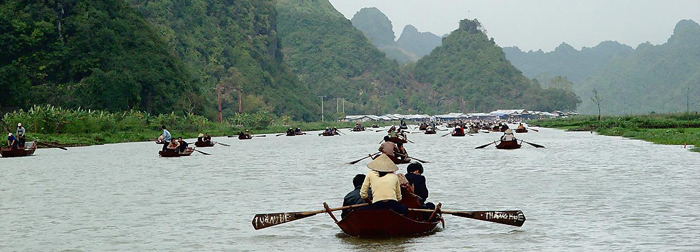
The Perfume Pagoda , located 70km south of Hanoi , is one of the most popular tourist sites in North Vietnam , not only by the beauty of its mountainous landscapes half but especially by the many Buddhist shrines located there . Many Vietnamese come here to pray to the success of their crops or their business. Those who do not have children, those who have only son or daughters will come simply to rub the head of a Buddha , a gesture that allows them , according to popular belief, having a child sex desired .
After an hour and a half drive from Hanoi, we reach the pagoda with a beautiful boat ride 3 Km on the Yen River. The boat passes through a beautiful landscape in the middle of rice fields and large limestone rocks. The tour begins with the cave scented Footprint, cave discovered there two thousand years and called by the Lord Trinh Sam (living in the 18th century) "the most beautiful cave in the South." Followed by two hours of walking sanctuaries marked with poetic names: "Pagoda accession to Heaven ", " Pagoda fairies "" Pagoda of purgatory" " Pagoda flavored footprint."
The Perfume Pagoda is one of the most beautiful excursions that can be done in the day from Hanoi, although it is much better to provide one to three nights on site in terms of rudimentary accommodation.
Tay Phuong Pagoda
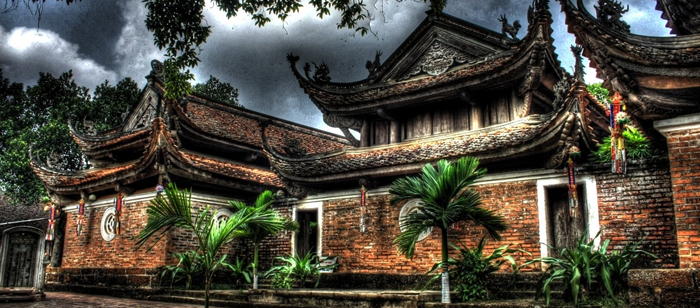
Perched on a hill, the picturesque Tay Phuong Pagoda is located 45 km west of Hanoi. It is reached by a road through the countryside, huge rice medium.
A staircase of 239 steps leads to the entrance of the pagoda. Built in the 7th century, it was restored in the late 17th century and in 1794 during the reign of the Tay Son. This is not only an important place of worship (pilgrimage festival and the 6th day of the 3rd lunar month), but also and above all a beautiful architectural ensemble.
The double roof of the pagoda, wood covered with tiles, with four slopes connected by strongly curved and decorated with dragon corners is a marvel of the art of wood carving in Vietnam.
This art can be admired through a superb set of statues of Buddha, the goddess of a thousand arms, and bodhissattvas disciples. The pagoda is often compared to a museum of Buddhist statues in the country.
Thay Pagoda

A few kilometers from Tay Phuong Pagoda, Chua Thay was founded during the reign of Ly Nhan Tong (1072-1128). Lilies, that were ardent propagators of Buddhism, did indeed build many pagodas around their new capital, Thang Long. Chua Thay is dedicated to the creator of water puppetry, the venerable Tu Dao Hanh bronze known by his exemplary religious life.
The pagoda consists of two buildings. In the first two phoenix carved carrying the king's letters. The altar of Tu Dao Hanh is in the middle, while on the right we find the king's throne. In the second, two huge statues of happiness and woe, and behind them, the statues of the four judges.
Facing the pagoda a beautiful lake (pond called dragon) gives the overall landscape character of sweetness and serenity. It was here that place puppetry water during the holidays.
Pagoda trail climbs to the top of the mountain, pierced with caves, some of which are converted into pagodas. At the top market of heaven opens on a large smooth rock where fairies and genies come to their boards and chess nights of the full moon.
Promotion
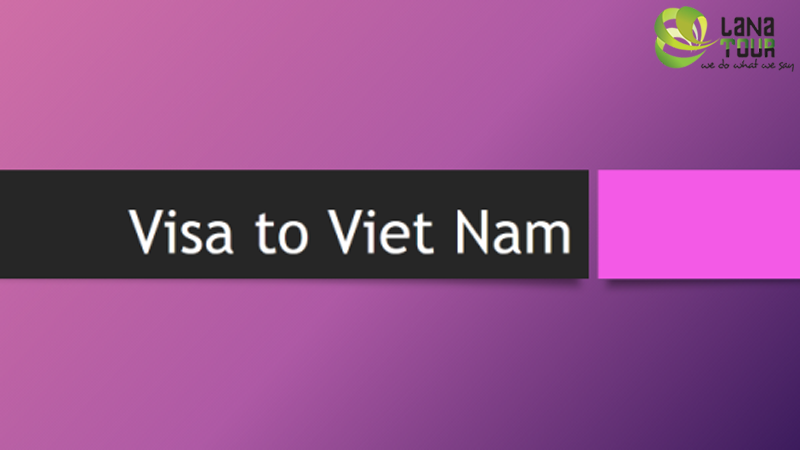
Free Visa Upon Arrival Letter
Are you going to Viet Nam next months? Don't you know how to get the visa? Don't worry about that because we can take care of this. Only one thing you have to do is sending us your copy of your passerport.
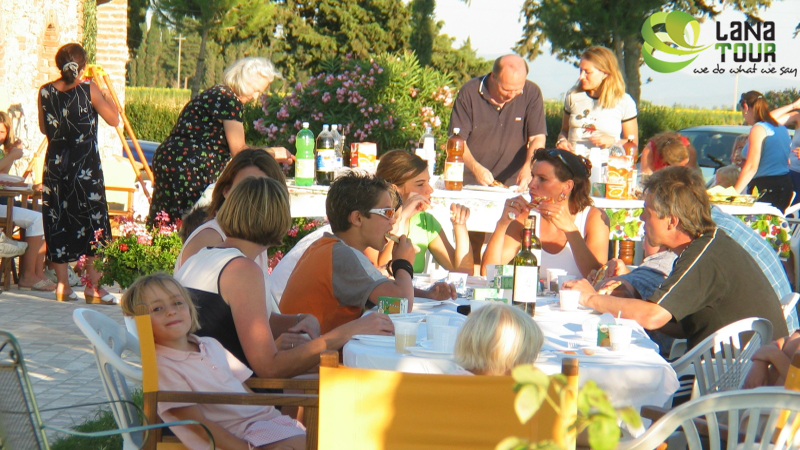
The Best Offer for Family
An idea circuit from North to South Vietnam through its beautiful sights, with a moderate rythm, the variety of activities for children, good accommodation for family.
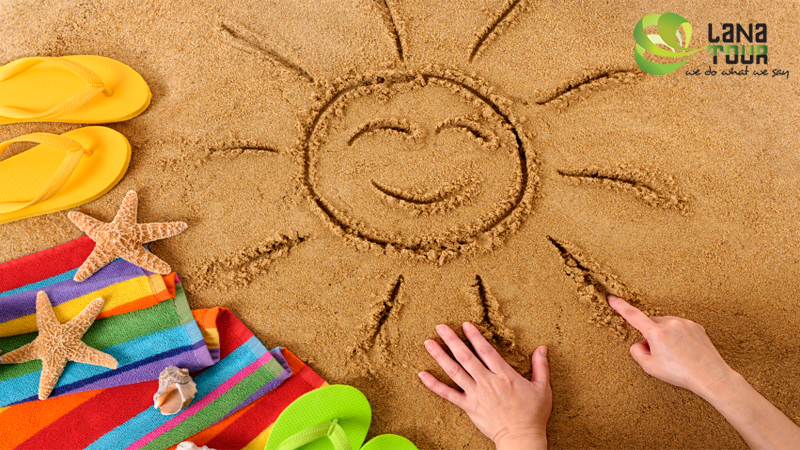
Summer Promotion
Summer is a great time to travel, to enjoy the beautiful beach but traveling with many attractive offres is a great thing even better. Please see below our special promotion for your summer trip


